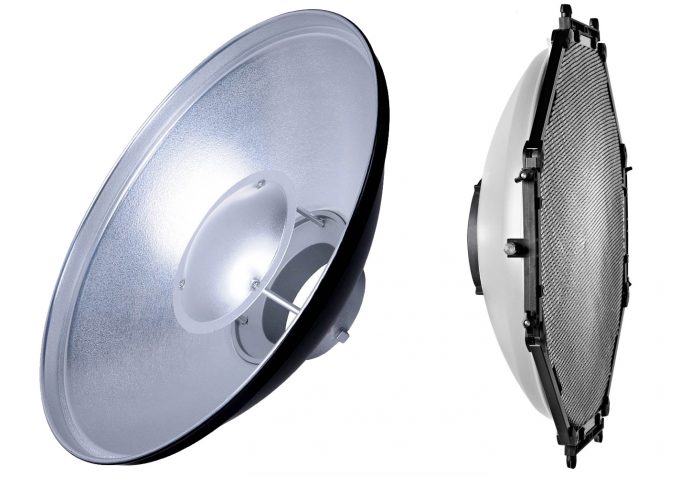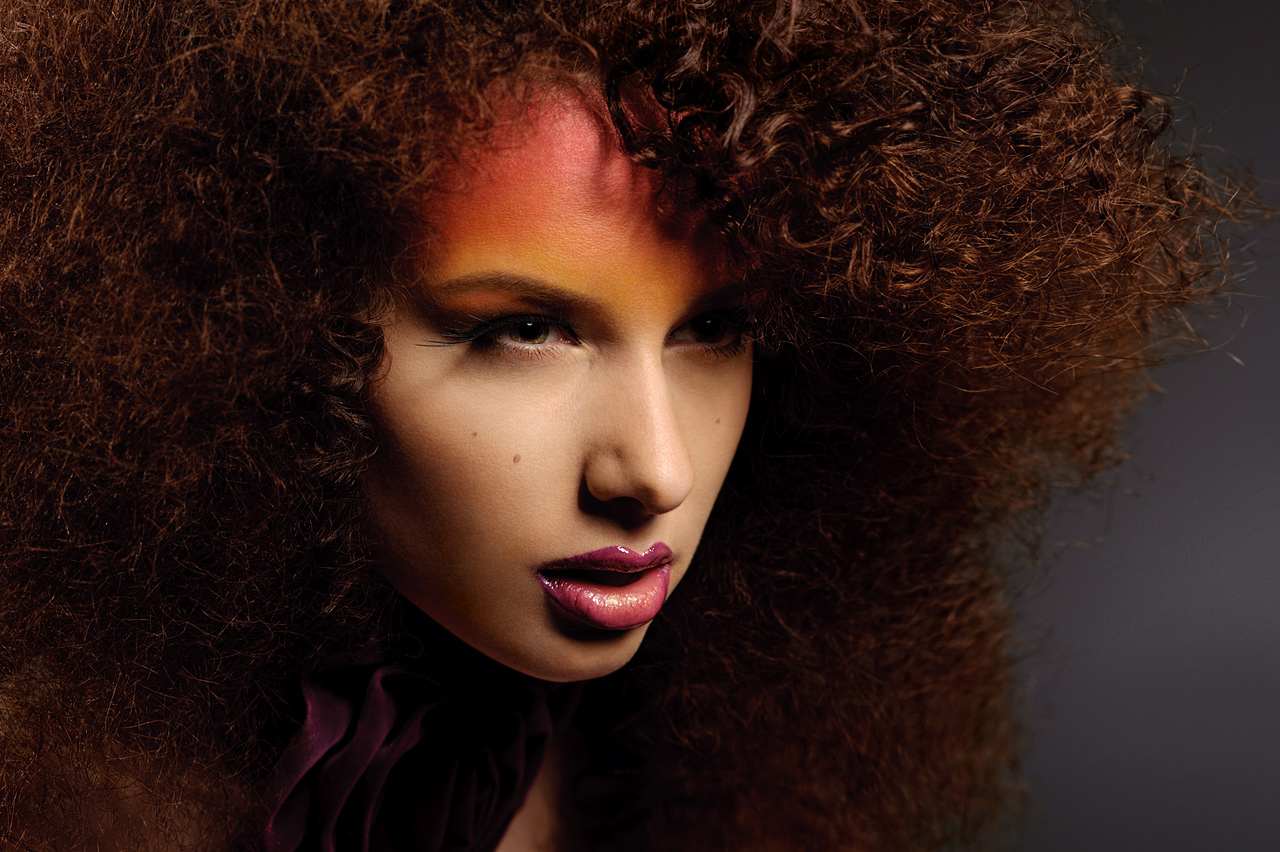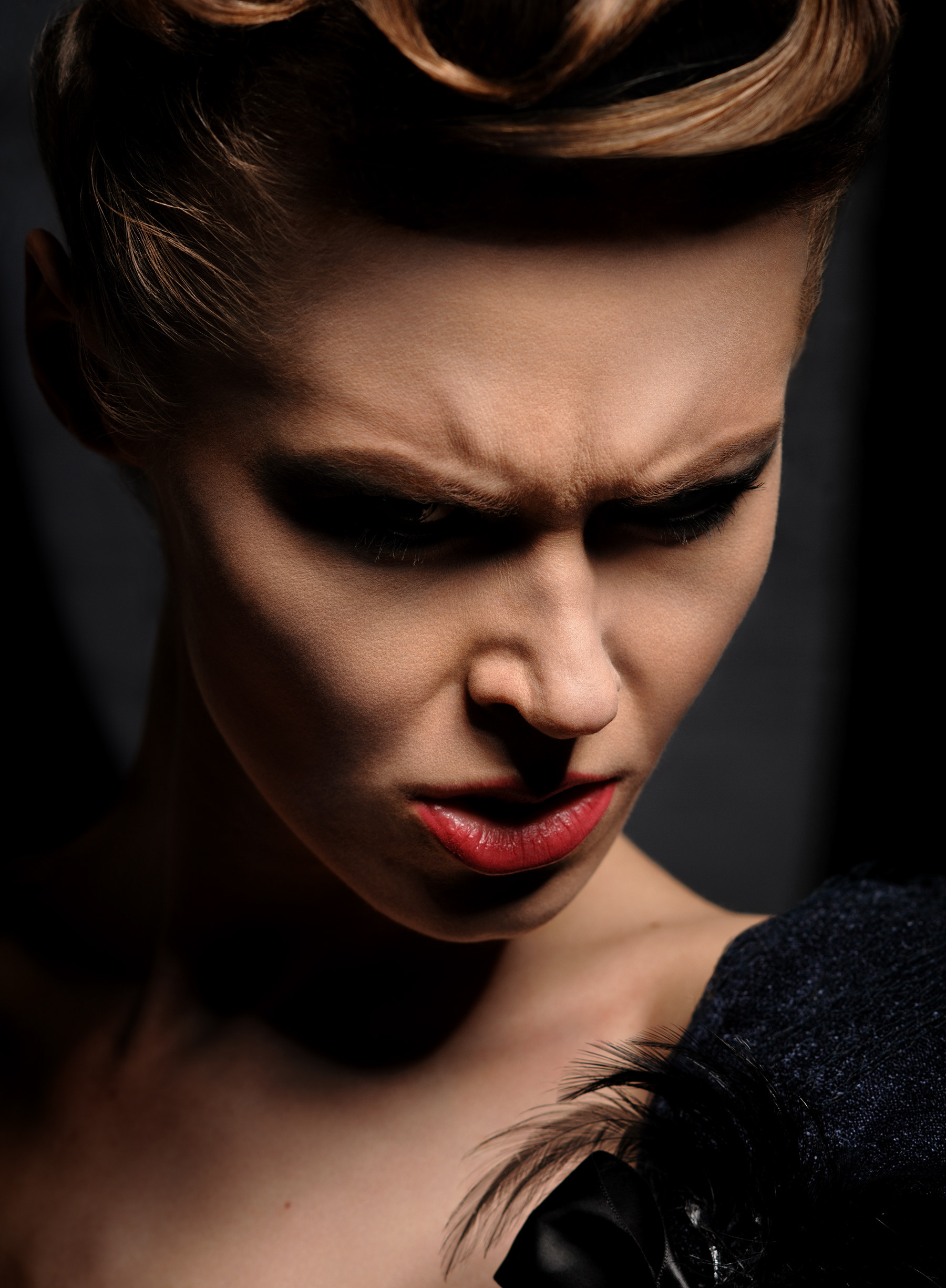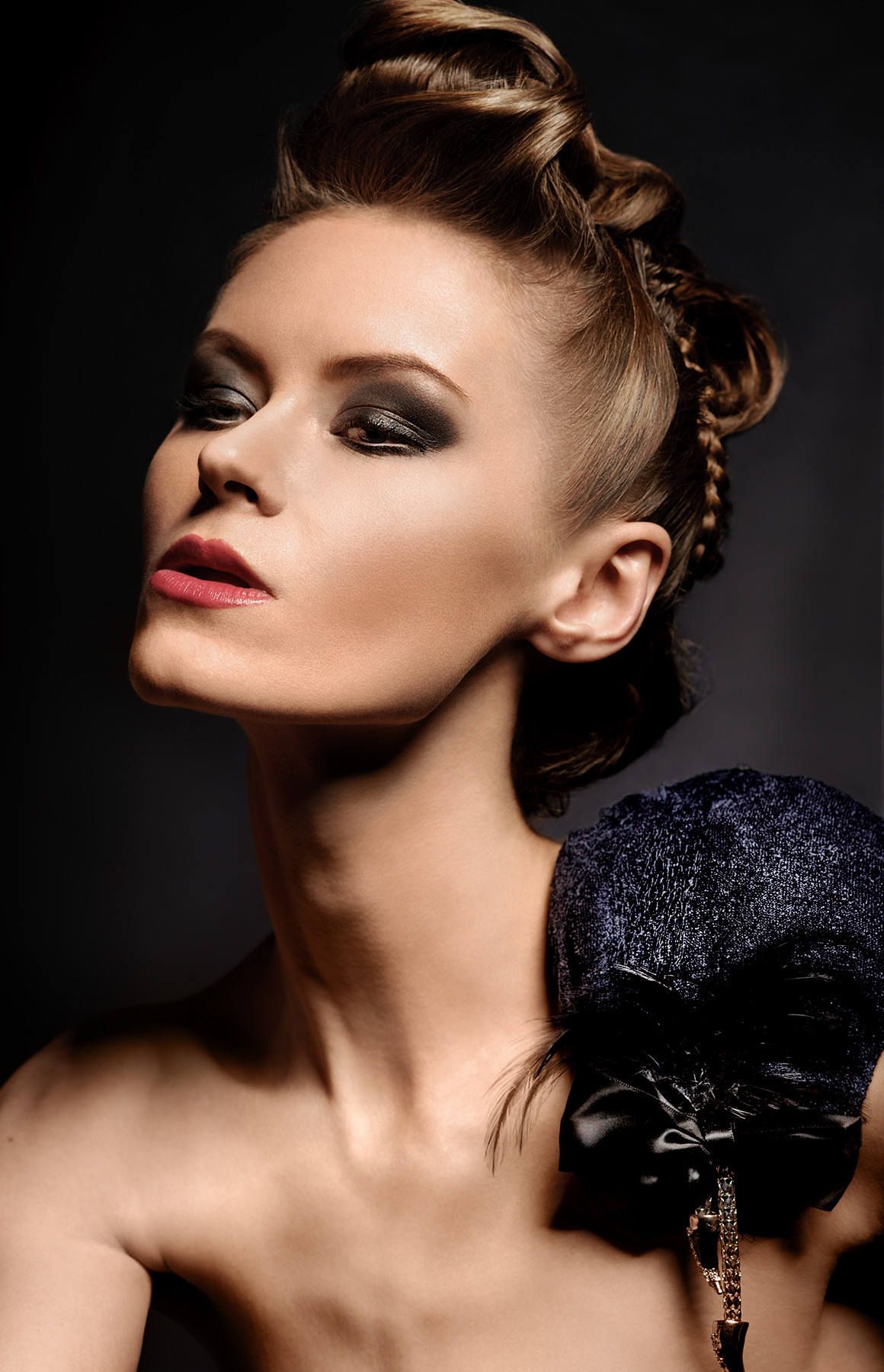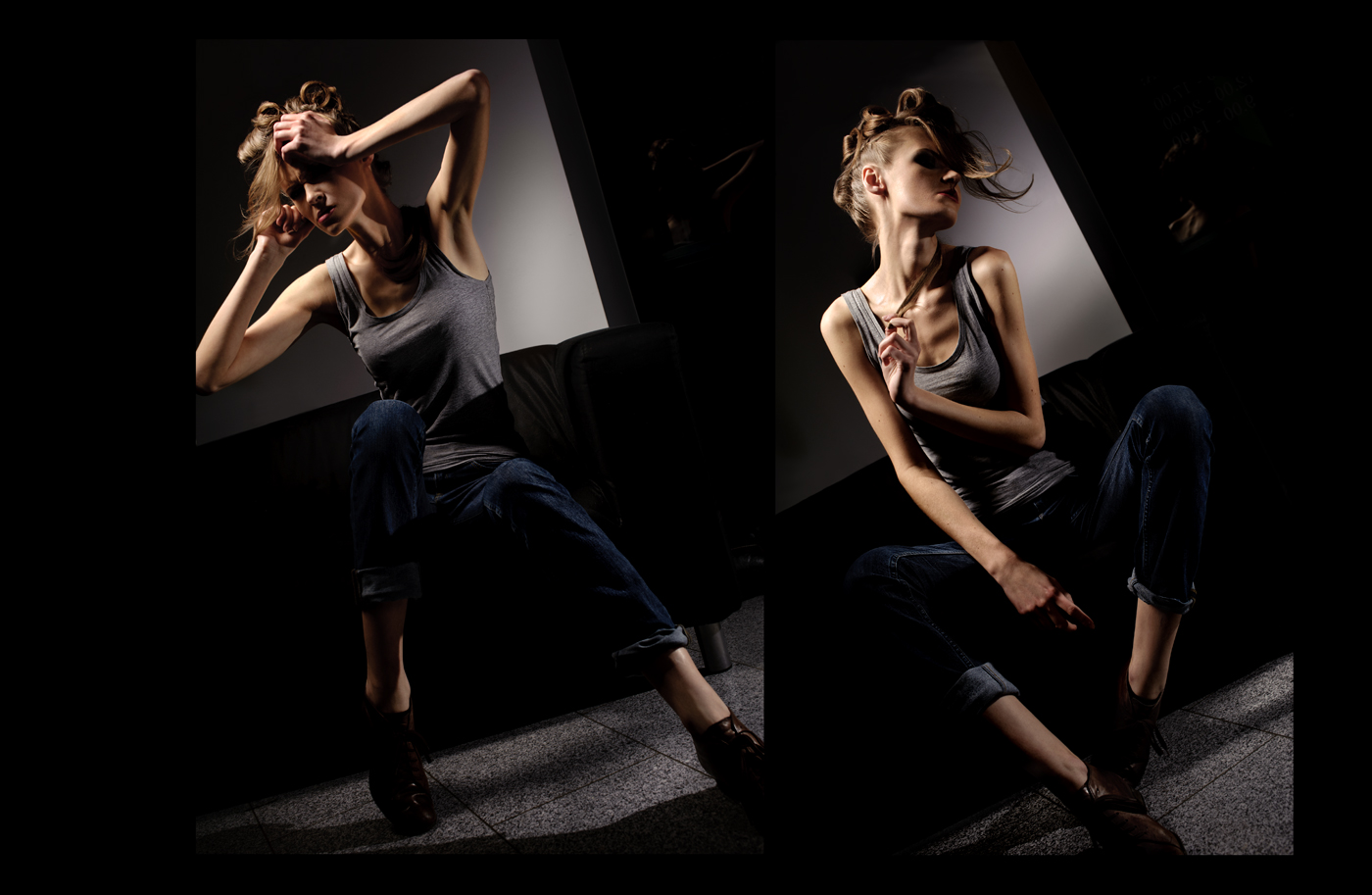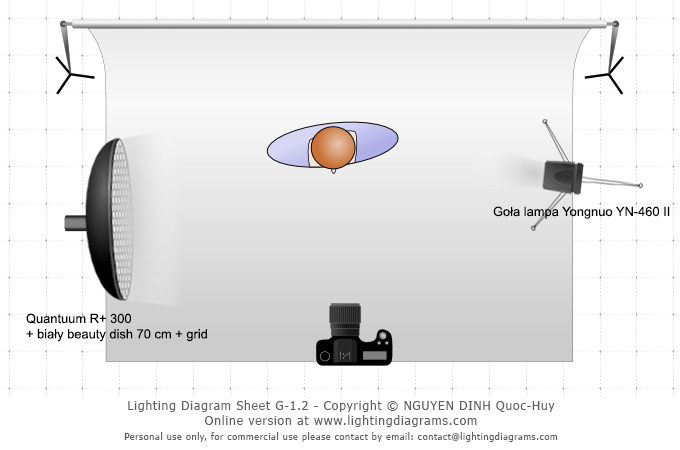I very often use a beauty dish as the key light, so I’ve decided to devote this post to it and thus give people unfamiliar with the topic a chance to learn what it is. It’s usually true that the softer the light, the better. Well, perhaps I am generalizing too much, but such is the widespread conviction. If I direct a light with no modifiers at my model, I will obtain hard light and the photo will look disastrous – coarse skin, hay-like hair and exceptionally unpleasant shadows. If I soften the light with a modifier (such as an umbrella or a softbox) put on its source, the result will be totally different: the skin will be smooth and the shadows will become much prettier – they will be soft and will fade mildly The BD is different: it provides hard light which, however, looks good. It is hard to achieve the same effect with any other modifier. BD is often compared to the sun because it is said to provide light a bit similar to sunlight, though I do not fully agree with this.
Hard light better accentuates the texture not only of the material (e.g. jeans looks a bit more 3D and there is more contrast to it than when you use a big softbox), but also of the skin, which happens to be a disadvantage. Thus, if you want to use a BD, you need a good make-up artist and you have to allow some more time for complexion retouch. Furthermore, it isn’t a good modifier to start learning how to reflect light. It’s much better to use an umbrella or a softbox at the beginning, but later on, when you grasp the idea, it’s worth while to consider getting a BD.
To the left, a standard beauty dish. To the right, a BD with a honeycomb grid by Elichrom.
Photos downloaded from here and here.
BD is very often used with a honeycomb grid. Thus, light becomes a bit harder and very precisely focused: it is directed just where you want it to be and little light escapes to the sides. To me, the grid is virtually a must-have: I very rarely use a BD without it. Sadly, it causes a significant loss of light – much bigger than the grid in softboxes because the BD grid is VERY dense, though the best producers offer several types. I used a 300 Ws light for a long time and its power was definitely insufficient. An 800–1200 Ws light would be just right for beauty shots because you wouldn’t have to worry about increasing the ISO value or decreasing the aperture value.
Beside the honeycomb grid, you can also put on a diffuser (actually, you can just as well use them both).
BD has three most popular sizes: 42, 55 and 70 cm. There are also smaller BDs for speedlights and larger ones for lighting a bigger space. Unfortunately, the size of the BD makes it problematic in transportation. It’s a metal bowl, so you can’t collapse it like other modifiers. It’s not that bad if you have a car, but if you use public transport, you had better think twice.
Moreover, the inside of the BD can be silver or white. Silver BDs usually provide a bit harder light, though it obviously depends also on the texture and on the surface of the inside (matt or nearly mirrored). My first choice was a 70 cm white BD, but it took quite a lot of time to find it in a set with a honeycomb grid. Most BDs are silver, though; moreover, everybody knows that it’s best to have BDs in both colors and several sizes :).
Why did I choose precisely that size? Well, a 70 cm BD is good for fashion shots, for which you need to position the light far enough to light the person evenly. It’s also perfect for beauty shots, where you need a small BD close to the model’s face; otherwise, light becomes hard in that unpleasant way I’ve mentioned before. What’s more, if the model shifts a bit, she will be lit differently and if she puts her hand on the face, the hand will be much brighter than the face. I have preferred to position lights further away from the model for a long time in order to avoid all those problems and focus on frames instead of continuous adjustments of the model’s pose. Of course, if you put a small modifier close to the model, the effect will be different than if you put a bigger one further away: in the former case, you will obtain more contrast. I’ve also had a chance to test a rather untypical BD by Fomei. It’s very deep, so it provides different light than the popular BDs made in China. Maybe I’ll write something more about that one in the future.
Interesting fact: Many amateur photographers do BDs themselves. They usually begin with a visit to a supermarket to find a metal bowl of an appropriate size, preferably a silver or a white one, or possibly one of any color – but then they must go to the shelf with sprays. If you want to test your skills and are looking for inspiration or just wish to see how others do it, simply type “DIY beauty dish” in your Internet browser.
Photo shoot
After this theoretical introduction, let’s proceed to practice. The photo shoots described below were taken using a 70 cm BD with a honeycomb grid. Beside it, I only used bare hair/background lights and sometimes also a reflector. My studio was Katarzyna Janoska’s hairdresser’s salon in Katowice, Poland. There wasn’t much space there for photographing, but I had already happened to take photos in even smaller spaces. Anyway, it turned out later on that the space was sufficient to take a fashion-like shot, too. Moreover, I had taken photos there several times before, so I knew where and how to position the model best to squeeze in the whole equipment. When it comes to models, two girls are described here. The first one is Dorota Kwiatkowska, whom you could see in Fotoerotica photos in Playboy at the time. Karolina Zientek, the person responsible for the make-up, let her imagination loose that day: the model’s forehead acquired the colors of a sunset and the lips became even more 3D. You can read a full description of doing that make-up on Karolina’s website, in this post (in Polish only). Kasia, in turn, made the afro hairstyle, which remained on the model’s head for several days after the photo shoot.
Lightning
I didn’t want to show that styling in a typical glamour-like way: I opted for something more dangerous, with deep shadows and dark background – something definitely my style. The final shot looks as follows:
135mm | F/6,3, 1/200s, ISO 200
The key light was a 70 cm white BD with a honeycomb grid, but it was insufficient to light the whole hairstyle, which stood out around the head so much. Thus, I directed another light (a Yongnuo YN-460 II speedlight) at the right side of the hairstyle (i.e. the left side of the photo), but with no modifier that time. Without that light, I’d have obtained a black patch there. The model was lit from the bottom with a silver reflector (but the effect was insignificant) and the background – with another YN-460 II light. The background was a 180 cm black reflector.
The second model is Beata Maj, whom I had wanted to photograph ever since I started taking photos. After a few shots I named her my discovery of the year 2012. She’s fantastic! We began with an “enraged” shot:
135 mm | F/7,1, 1/200s, ISO 200
Of course, the key light was still a 70 cm BD directed straight at the face. It hung quite high, as you can judge by the shadow under the nose. I directed another light (YN 460 II) at the background (a black reflector as usual).
For the next two shots I positioned the light rather untypically when it comes to my preferences: I lit the part of the face which was closer to the camera. This causes the face to look flatter. Many people like such light, but I definitely prefer sharp facial features. However, Beata’s are sharp enough to look perfect even in such light:
135 mm | F/7,1, 1/200s, ISO 200
And here is another shot (the same setup, but a different pose):
135 mm | F/7,1, 1/200s, ISO 200
And here is another shot (the same setup, but a different pose):
50 mm | F/7,1, 1/160s, ISO 200
The space was limited, especially for using a 135 mm lens. The space was limited, especially for using a 135 mm lens. I had to step so far back that I stood up against the wall and still pushed the viewfinder against the eye as much as I could in order to get at least a fraction wider frame :). I finally decided that the shot would be more dynamic if taken with a 50 mm lens, anyway, and I did so.
Summary
If you are considering the purchase of a BD, you should definitely buy it because it will allow you to experiment with light in many new ways. If you happen to dislike it, you can always resell it or send it back to Amazon etc. I take almost all my shots using a BD Maybe it will change one day, but today I can see no signs of it.

